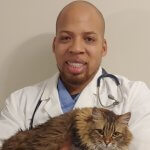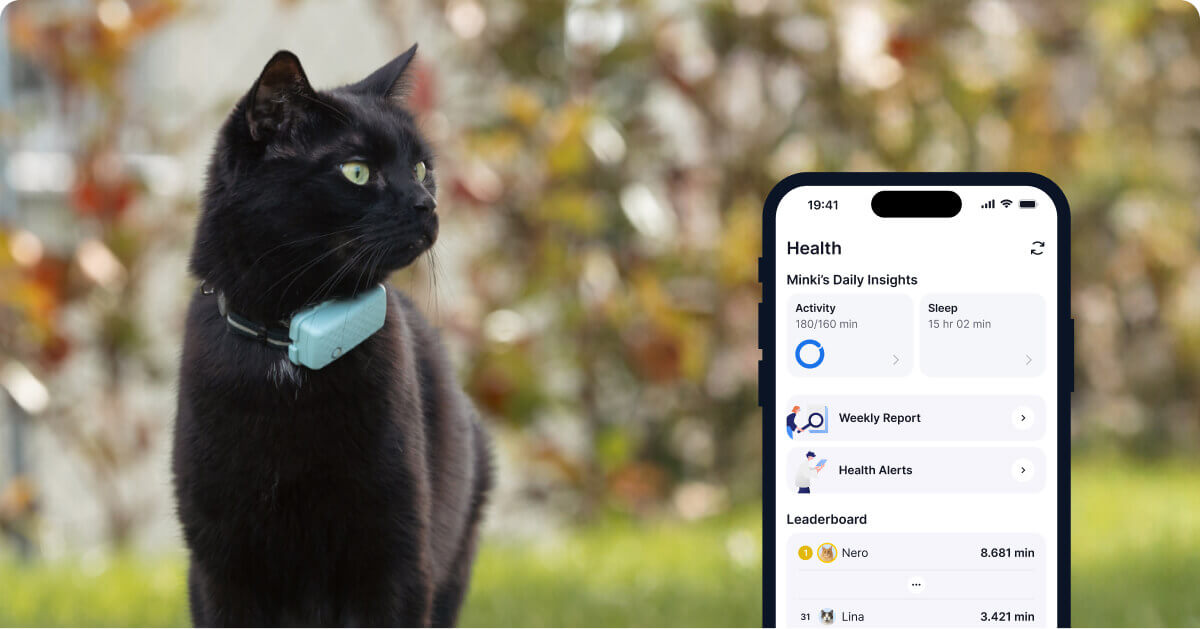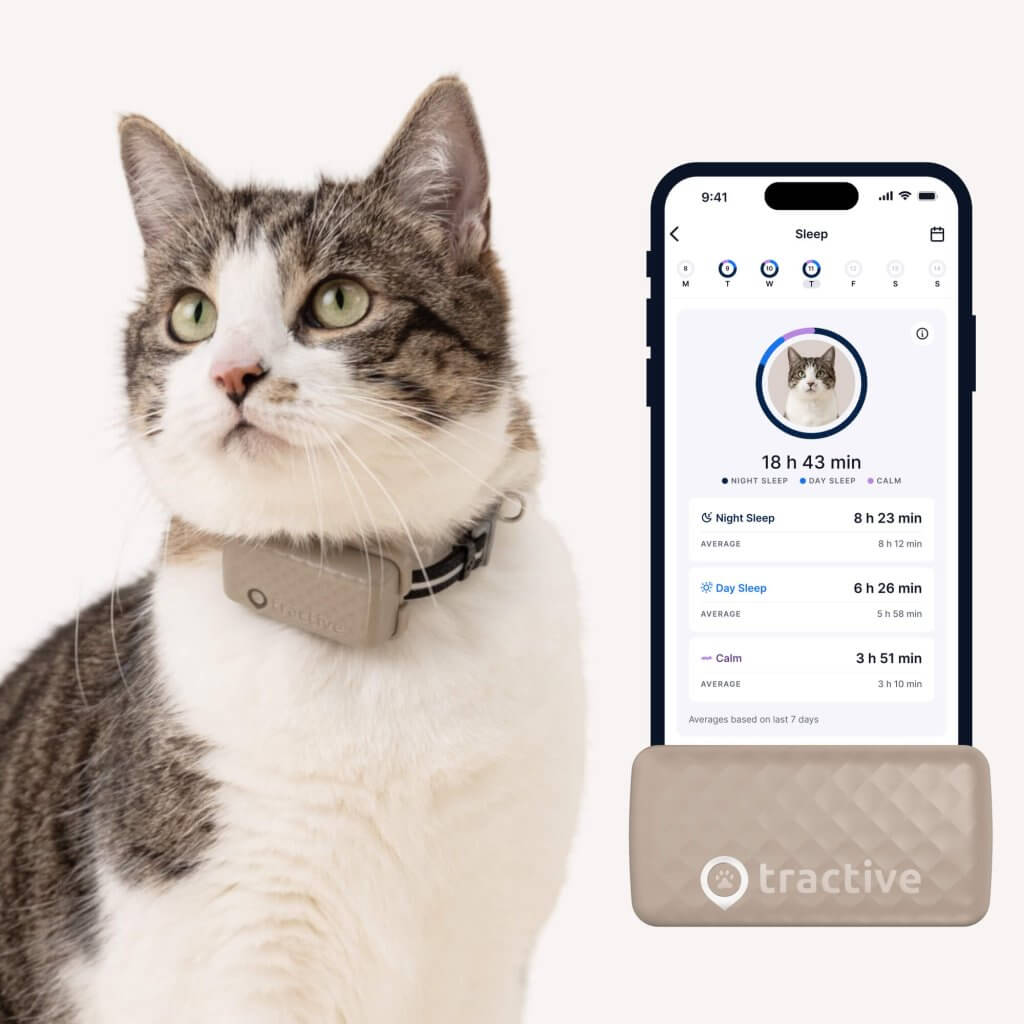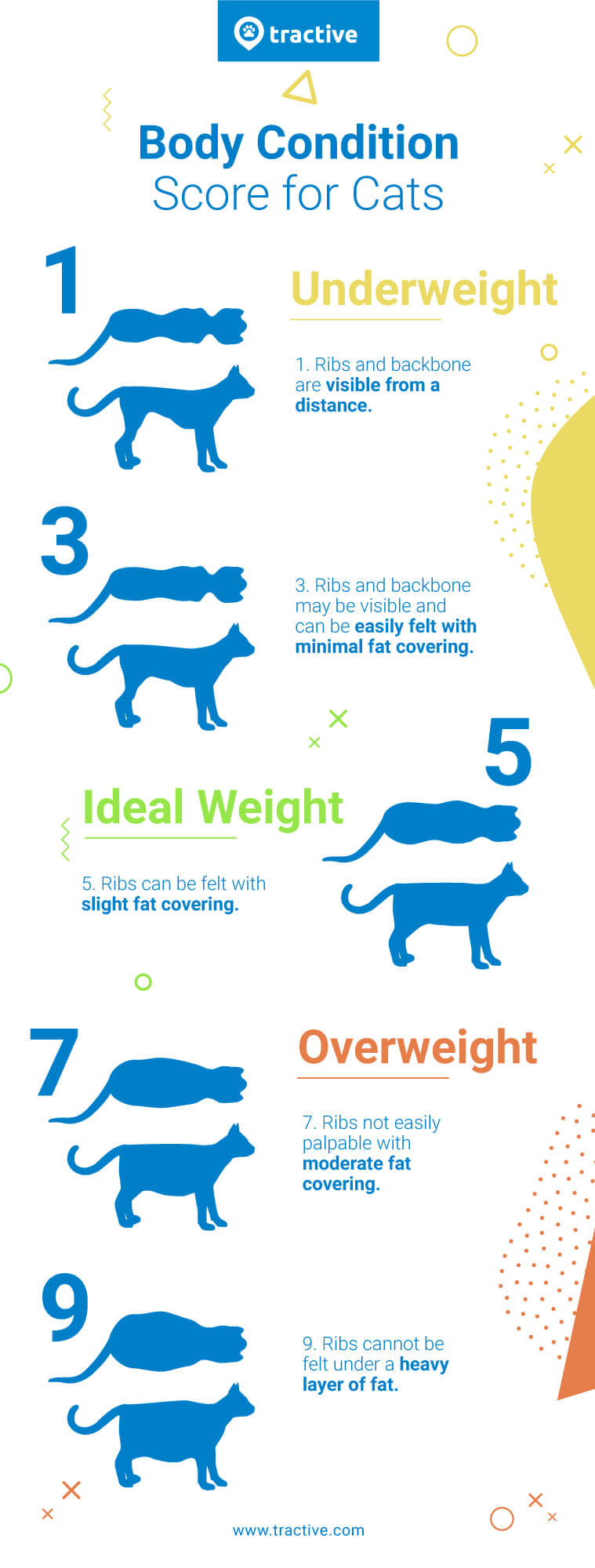 Approved by Dr. Dwight Alleyne (DVM)
Approved by Dr. Dwight Alleyne (DVM) Cat Body Condition Score: Is Your Cat At A Healthy Weight?
Need help figuring out if your cat is too skinny, a bit overweight, or just right? Start here.
If you’re a health-conscious cat parent, you might’ve wondered whether your buddy is at a healthy weight. And a great way to figure that out? Be mindful of your cat’s body condition score – besides their body mass index (or BMI.) Aka, a great option for if you don’t have a weighing scale at home. Here’s how to figure it out – and how you can keep your cat in the best shape of their lives.
Key Takeaways
The Body Condition Score is a tool to assess a cat’s weight.
It’s a scale from 1 to 9 used to determine if a cat is underweight, at a healthy weight, or overweight. The ideal score is 4 or 5.
A healthy weight requires diet and exercise.
Follow your vet’s instructions to keep your cat on a balanced diet of high-quality food. Make sure to keep them active and provide them plenty of toys and playtime.
Use a smart cat collar with Health Monitoring.
Your Tractive device has a built-in motion detector that tracks your cat’s daily movements and helps you figure out how much exercise they’re getting. It even shows you how many calories they’ve burned, so you can portion out their food servings accordingly.

Find out where your cat spends their time.
Read more- Key Takeaways
- Cat Body Condition Score: What it is & and how it works
- How to figure out your cat’s body condition score
- Understanding your cat’s body condition score
- My cat is underweight – what can I do?
- My cat is overweight – what can I do?
- How can I help my cat maintain a healthy weight?
- How a smart cat collar with Health Monitoring can help
Cat Body Condition Score: What it is & and how it works
The Cat Body Condition Score (BCS) is a tool you can use to determine your cat’s body fat levels and see if they’re too thin, too fat, or at a healthy cat weight. It’s one way to determine whether your cat’s weight falls within a normal or healthy range, or if they might be underweight or overweight.
As the name suggests, the BCS for cats rates a cat’s physical condition using a scale from 1 to 9. On this scale, a BCS of 1 means a cat is malnourished or emaciated (in other words, dangerously underweight.) While a score of 9 indicates cat obesity.
How to figure out your cat’s body condition score
Checking your cat’s body condition score involves using your eyes to observe your cat’s body shape, as well as feeling their rib cage gently with your hands.
- Run both hands – palms down – across your cat’s rib cage.
- Take a look at your cat from the side and above.
- Compare what you notice about your cat’s physical condition with the Body Condition Score chart for cats below.
A body condition score of 4.5-5 is considered a healthy range for cats. Here’s a handy infographic to help you get an idea:
Understanding your cat’s body condition score
Determined your cat’s body condition score using the chart above? Here’s what their results might mean.(Just be mindful that some cats do tend to be on the skinnier side – and it’s 100% natural. Trimmer cat breeds include Cornish and Devon Rexes, Siamese cats, Abyssinians, and Oriental Shorthairs.)
- 1-2: Malnourished
Here, you can clearly see the cat’s ribs and backbone from a distance. There is little to no body fat. This often happen to cats who don’t have a steady family caring for them. However, it can also affect cats who don’t eat enough food or don’t eat the right kind of food. Make sure to seek a vet’s help as soon as possible. - 3: Underweight
Your cat’s ribs and backbone may be visible, and you can easily feel their ribs with your hands. There is only minimal fat covering. The cat has an obvious waist, and very minimal belly fat. Some senior cats may take on a more “bony” look, as they often eat and move less than younger cats. They may also be facing health issues that impact their appetite and energy level.
- 4-5: Ideal weight
Cats at this stage have neither too little, nor too much fat. You can feel their ribs, with a slight fat covering, but are not visible. There is a minimal layer of fat around the belly. They are well-proportioned, with their waist visible from above (behind the ribs). - 7: Overweight
At a score of 7, it’s not easy to feel a cat’s ribs, which are covered by a moderate layer of fat. From above, it is not easy to make out the cat’s waist. The belly area is noticeably round, with a moderate fat pad around the abdomen. - 8-9: Obese
At this stage, the cat’s ribs cannot be felt – they are under a heavy layer of fat. There is no visible waist from above. Instead, you can see and feel an obvious rounding of the belly and extensive fat deposits around their belly, lower back, face and legs.
My cat is underweight – what can I do?
Cats with a body condition score of 1-3 are usually in need of medical intervention. First, talk to your vet to rule out any underlying health issues. They can best help you figure out an eating schedule and appropriate food servings to get your cat to a healthy weight. Your vet might also recommend deworming your cat in case parasites or an infection are the cause.
Next, watch out for any bullying behaviors among other cats at feeding time. It could be that another, more dominant cat might be shoving your poor cat out of the way when the food bowls come out! Meaning it’s a good idea to feed them separately and keep them apart during feeding times.
If these aren’t the cause, take a look at what you’re feeding your cat. It’s a good idea to increase how many healthy protein and fat sources they eat, since cats are obligate carnivores. Try adding a little extra food to their bowl every day to encourage them to eat.
My cat is overweight – what can I do?
Sadly, obese cats are at risk for a wide range of health issues that may shorten their lives – so it’s important to take cat obesity seriously. Talk to your vet first to figure out weight-reduction measures that are right for your feline. This could include a calorie-restricted diet or increased activity. At the same time, make these changes gradual. I.e., don’t make a big change to your cat’s diet overnight. Go slow and gradually reduce their portion sizes with the help of your vet.
If you notice your cat has been eating more, or is less active than usual, these behaviors may be warning signs of health issues. Cats around middle age may also naturally start to gain weight as their metabolism slows down. If you can’t identify the source of the weight gain, talk to your vet. Also, make sure none of your friends, family members, neighbors, or guests are feeding your cat some extra snacks and treats on the sly!
💡A Tractive smart cat collar can help you figure out how much activity your cat is getting – and also how many calories they’ve burned throughout the day. So you can portion out their food servings and help them lose those extra pounds.
How can I help my cat maintain a healthy weight?
Much like us humans, two of the main factors that will help your cat maintain a healthy weight are diet and exercise.
Diet
Make sure you are feeding your cat the right amount – and the right kinds of food. If you’re not sure which food is best for your cat, how much and how often to feed them, talk to your vet.
Here are some general guidelines for feeding your cat:
- Choose high quality cat foods, preferably with protein as the main ingredient
- Feed a mix of dry and wet cat foods – dry food only is more likely to lead to obesity, since it has more calories. Wet food can be more filling and hydrating overall.
- Avoid free feeding, and instead feed your cat at regular intervals through the day (4-5 small meals is recommended)
- Use a puzzle feeder to slow down feeding time
- Make sure your cat has access to fresh drinking water all the time
Exercise
Besides a healthy diet, getting your cat to move is a huge part of keeping them at a good weight. More activity not only burns calories but also keeps their muscles strong and joints limber. Plus, it’s a great way to fight boredom, stop destructive habits, and just have some fun together.
Cats are natural-born hunters. They’re built for short, high-energy bursts of play, not long-distance runs. Try to get them playing for about 10 to 15 minutes at least twice a day, especially before they eat. This naturally taps into their natural “hunt, catch, eat” routine. Besides, here are a couple of ways to keep your cat active at home:
- Rotate their toys
Don’t leave all the toys out at once. Keep a few favorites stashed away and swap them out every few days. This keeps things fresh and exciting, so your cat won’t get bored with the same old stuff. - Try interactive toys
Grab a feather wand, a laser pointer (just be careful not to shine it in their eyes), or a catnip mouse. Make the toy act like prey – darting around and hiding – to keep your cat on their toes. - Use food puzzles
Instead of just putting their food in a bowl, try a puzzle feeder. They’ll have to “work” for their meal, which slows down their eating and gives them a mental workout. - Set up some vertical spaces
Cats love to climb and watch the world from up high. A good cat tree or some wall shelves can give them a fun workout and a new perspective. A sturdy scratching post is also a great way for them to stretch those muscles.
Read More: How To Get A Cat To Exercise: 5 Fun Activities
How a smart cat collar with Health Monitoring can help
Staying accountable to any diet and exercise regime can be stressful. But with a smart cat collar like Tractive, it needn’t be. Strapped to your cat’s collar, it’s like having a little personal trainer and health monitor right on your cat.

Now with just a glance at your phone, you can:
Track how much exercise your cat’s getting
Your Tractive device’s built-in motion detector keeps tabs on your cat’s movements throughout the day. With the Activity Tracking feature, you’ll be able to see if they’re having a super active day full of zoomies or if they’re taking it easy with more naps than usual. This gives you a clear picture of their activity levels, so you can make sure they’re getting enough playtime to stay healthy.
Spot potential health issues early
Beyond just tracking activity, Tractive also offers Health Alerts. If there’s a significant change in your cat’s activity or sleep patterns, the collar can alert you. This can be super helpful because a sudden drop in activity, for instance, might be a subtle sign that something’s not quite right, prompting you to keep a closer eye on them or check in with your vet.
Keep track of how many calories your cat has burned
Finally, if you’re helping your cat lose weight, the collar can even show you how many calories your cat has burned. Now you can make informed decisions about their food. If you know how active they’ve been and roughly how many calories they’ve used, you can adjust their food portions accordingly. No more guessing games – you can ensure they’re eating just the right amount to maintain that ideal body condition score.
With a smart cat collar, it’s all about giving you the insights you need to keep your cat happy, healthy, and at a great weight.

Help your cat stay fit and healthy
Get a complete overview of how much exercise and rest they’re getting. Compare their activity to that of similar cats. Set daily goals.
And if you’ve liked this post, share it with a friend or a loved one – and let’s help build a safer, kinder world for our furry friends together.
Your furry friend’s health and wellbeing means as much as to us as it does to you. So we’ve made it a priority to only share medically-relevant content on our blog. This post was checked, double-checked, and medically verified by Georgia-based vet, Dr. Dwight Alleyne.

Dr. Dwight Alleyne (DVM)
Originally from Long Island, New York, Dr. Alleyne began his career at a no-kill animal shelter before becoming a licensed veterinary technician. He graduated from Cornell University Veterinary College in 2006 and completed an internship at Purdue University. Now practicing in Georgia, Dr. Alleyne specializes in soft tissue surgery and ultrasounds. He also writes pet health articles on his website, “The Animal Doctor Blog” (www.anmldrblog.com).




